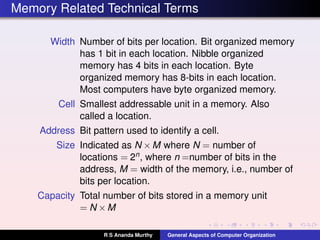L6 primary-memory
- 1. General Aspects of Computer Organization (Lecture-6) R S Ananda Murthy Associate Professor and Head Department of Electrical & Electronics Engineering, Sri Jayachamarajendra College of Engineering, Mysore 570 006 R S Ananda Murthy General Aspects of Computer Organization
- 2. Memory Access Time, RAM and SAM The time interval between the application of MEMREAD signal to the memory and appearance of data on the data bus of the memory is called Memory Access Time. A memory unit is called Random Access Memory (RAM) if the access time is same for all the locations in the memory unit. All semiconductor memories are RAM. A memory unit is called Sequential Access Memory (SAM) if the access time varies depending upon the address or the location of data in the unit. Eg. Magnetic disks and tapes. In microcontroller-based systems we may not need external memory if the internal memory in MCU is sufficient. R S Ananda Murthy General Aspects of Computer Organization
- 3. Types of Semiconductor Memory ROM A memory chip pre-programmed by the manufacturer. User cannot alter its contents. Non-volatile. Also known as masked ROM. PROM Programmable Read Only Memory can be programmed only once by the user. Cannot be reprogrammed. Non-volatile. EPROM Erasable PROM can be programmed, contents of all locations are erased by exposing to ultraviolet light for several minutes (typically in 15-60 minutes), and can be reprogrammed by the user. Non-volatile. R S Ananda Murthy General Aspects of Computer Organization
- 4. Types of Semiconductor Memory EEPROM Electrically Erasable PROM can be programmed, contents of selected locations can be erased electrically (typically in 1-10 s), and reprogrammed by the user. Non-volatile. Flash A type of EEPROM having faster erase cycles as compared to non-flash EEPROM (< 1s). Non-volatile. Can be electrically erased and reprogrammed. Used as program memory in MCUs. SR/WM Static Read/Write Memory. Volatile. Each bit is stored in a flip-flop. Commonly called SRAM. Cache memory is of this type. Very fast and costly memory as compared to DRAM. Used as data memory in MCUs. R S Ananda Murthy General Aspects of Computer Organization
- 5. Types of Semiconductor Memory NV-R/WM Non-volatile Read/Write Memory. Each bit is stored in a flip-flop as in SRAM. Commonly called NV-RAM. Has a built-in lithium-ion battery. When there is no power supply, because of the battery backup, contents are retained typically for upto 5-10 years. DR/WM Dynamic Read/Write Memory. Volatile. In this each bit is stored as a charge on a capacitor. Frequent refreshing is required, typically every 6-8 ms, to retain data. Commonly called DRAM. Cheaper than SRAM. Used as primary memory in desktop computers and laptops. R S Ananda Murthy General Aspects of Computer Organization
- 6. Memory Images UV Erasable EPROM DRAM Module SRAM R S Ananda Murthy General Aspects of Computer Organization
- 7. Memory Related Technical Terms Width Number of bits per location. Bit organized memory has 1 bit in each location. Nibble organized memory has 4 bits in each location. Byte organized memory has 8-bits in each location. Most computers have byte organized memory. Cell Smallest addressable unit in a memory. Also called a location. Address Bit pattern used to identify a cell. Size Indicated as N ×M where N = number of locations = 2n, where n =number of bits in the address, M = width of the memory, i.e., number of bits per location. Capacity Total number of bits stored in a memory unit = N ×M R S Ananda Murthy General Aspects of Computer Organization
- 8. Big Endian and Little Endian Byte Ordering 0x90AB12CD900x1000 AB0x1001 120x1002 CD0x1003 Hex Address CD 0x1000 12 0x1001 AB 0x1002 90 0x1003 Hex Address32-bit Number Big Endian Little Endian In big endian computers, the higher significant byte is stored at lower address. Eg. Motorola processors and Sun SPARC processors follow big endian storage. In little endian computers, the lower significant byte is stored at lower address. Eg. Intel processors and IBM mainframes follow little endian storage. In MIPS processors user can select big or little endian storage. R S Ananda Murthy General Aspects of Computer Organization
- 9. License This work is licensed under a Creative Commons Attribution 4.0 International License. R S Ananda Murthy General Aspects of Computer Organization









